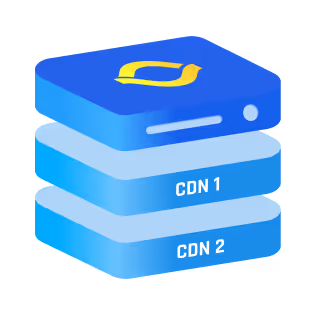Can you build powerful applications without getting bogged down in server management? Yes? What enables it? The answer is serverless computing.
It's a cloud-based development approach that lets you focus on writing clean code, leaving the server headaches to someone else.
What is Serverless Computing?
Serverless computing is a cloud computing model where the cloud provider manages the infrastructure, allowing developers to focus solely on writing code. This means no more worrying about server maintenance, scaling, or capacity planning. Instead, the cloud provider automatically handles all that, making your life as a developer a whole lot easier.
When we say "serverless," it doesn’t mean there are no servers involved. Servers are still there, but the key difference is that you don’t have to manage them. The cloud provider takes care of all the heavy lifting, such as provisioning, scaling, and managing the servers. You just upload your code, and the provider ensures it runs smoothly.
{{cool-component}}
Example
Think of it like this: you want to host a party, but instead of cooking, cleaning, and setting up the venue yourself, you hire a party planner. The planner handles all the logistics, and you just enjoy the party. That’s what serverless computing does for your applications.
Serverless computing allows you to build and run applications and services without worrying about the underlying infrastructure. It's like having a team of invisible helpers that ensure everything runs efficiently and scales automatically based on demand.
How Serverless Computing Works
The beauty of serverless computing lies in its simplicity and efficiency. Here’s a step-by-step breakdown of the process:
1. Write Your Code
First things first, you write your code. This code could be a simple function or a more complex piece of logic that forms part of your application.
The key here is that your code is designed to perform specific tasks or respond to particular events.
2. Upload to the Cloud Provider
Once your code is ready, you upload it to a cloud provider that offers serverless computing services.
Major players in this space include:
- AWS Lambda
- Google Cloud Functions
- Microsoft Azure Functions
These platforms are designed to take your code and handle everything else.
3. Event Triggers
Serverless computing operates on an event-driven model. This means that your code will be triggered by specific events.
Events can range from HTTP requests, file uploads, database changes, or even scheduled tasks. When an event occurs, it automatically triggers your code to run.
4. Automatic Scaling
One of the standout features of serverless computing is automatic scaling. Traditional server management requires you to predict and provision the right amount of resources to handle varying loads.
With serverless computing, the cloud provider automatically scales the resources up or down based on demand.
If your application suddenly receives a surge in traffic, the provider ensures your code runs seamlessly without any manual intervention.
5. Execution and Resource Management
When your code is triggered, the cloud provider allocates the necessary resources to execute it. This includes CPU, memory, and other essential resources.
The best part? You don’t have to worry about managing these resources. The cloud provider handles it all behind the scenes.
Where Can Serverless Computing be Used?
Serverless computing is powering production systems across industries. Here are some real-world scenarios where serverless shines:
- API Backends: Build RESTful or GraphQL APIs that automatically scale with user demand.
- Scheduled Tasks: Run cron jobs for things like generating daily reports, clearing old data, or syncing files.
- Real-Time File Processing: Automatically resize images, transcode video, or scan uploads for malware as soon as files hit your storage bucket.
- Third-Party Webhook Consumers: Handle webhook events from services like Stripe, Shopify, or GitHub without provisioning backend servers.
- ETL Pipelines: Transform and load data on-demand from one system to another, triggered by changes or events.
CI/CD Automation: Automate deployment steps, send Slack alerts, or trigger builds based on code commits or approvals.
{{cool-component}}
Serverless Computing vs. Cloud Computing
While both serverless computing architecture and traditional cloud computing aim to simplify infrastructure management and boost scalability, they differ significantly in their approaches. Traditional cloud computing involves renting virtual servers and managing their configurations, scaling, and maintenance.
In contrast, serverless computing abstracts these tasks entirely, allowing developers to deploy code without worrying about the underlying infrastructure.
This means that with serverless computing, the cloud provider handles all server management, scaling automatically based on demand, and billing based on actual usage.
Benefits of Serverless Computing
Serverless computing isn't just a trendy buzzword; it offers tangible benefits that can revolutionize the way you develop and deploy applications.
Here are some key advantages:
1. Cost Efficiency
One of the most compelling benefits of serverless computing is its cost efficiency. Traditional server-based models require you to pay for server uptime, regardless of actual usage.
With serverless computing, you only pay for what you use. This means you're billed based on the actual execution time of your code, the number of requests, and the resources consumed.
No more overprovisioning or paying for idle server time!
2. Automatic Scaling
Serverless computing shines when it comes to scalability. The cloud provider automatically scales your application up or down based on demand.
Whether you have a sudden spike in traffic or a lull, the system adjusts seamlessly, ensuring optimal performance without manual intervention.
This is particularly beneficial for applications with variable workloads.
3. Reduced Operational Overhead
With serverless computing, you can kiss goodbye to server management tasks.
The cloud provider handles all the infrastructure management, including server provisioning, maintenance, patching, and updates.
This allows you to focus on writing code and developing features, rather than getting bogged down by operational concerns.
4. Faster Time-to-Market
Serverless computing accelerates your development process. By eliminating the need to manage infrastructure, you can quickly develop, test, and deploy applications.
This is especially valuable for startups and businesses looking to bring products to market rapidly.
The ease of deployment and automatic scaling capabilities mean you can respond to market demands and iterate faster.
5. Built-in Fault Tolerance
Serverless platforms come with built-in fault tolerance and high availability. The cloud provider ensures your application is resilient to hardware failures and other issues.
Your code is distributed across multiple servers and data centers, reducing the risk of downtime and improving reliability.
6. Focus on Innovation
By offloading infrastructure management to the cloud provider, you and your team can concentrate on innovation.
Serverless computing frees up your time and resources, allowing you to experiment with new ideas, develop cutting-edge features, and improve your application's functionality.
7. Environmentally Friendly
Serverless computing can also have a positive impact on the environment. By utilizing resources more efficiently and scaling automatically based on demand, it reduces the carbon footprint associated with over provisioned servers and idle computing power.
This aligns with the growing emphasis on sustainable and eco-friendly technology practices.
{{cool-component}}
Disadvantages of Serverless Computing
As powerful as serverless is, it’s not the silver bullet for every application. There are trade-offs worth considering:
- Cold Starts: Functions that haven’t been used in a while may take longer to boot up, causing delays for the first request.
- Vendor Lock-In: You’re deeply tied into a specific cloud provider’s ecosystem, which can make migrations difficult later.
- Limited Control: You don’t have visibility into or control over the underlying infrastructure, which can be a deal-breaker for highly regulated environments.
- Debugging Complexity: Observability and step-through debugging can be trickier compared to monolithic or container-based applications.
- Execution Time Limits: Most serverless platforms restrict how long a function can run (e.g., AWS Lambda caps at 15 minutes).
Key Components of Serverless Architecture
Understanding the key components of serverless architecture is essential to fully grasp how it works and how to leverage its benefits effectively.
Here are the primary elements:
1. Functions-as-a-Service (FaaS)
The core of serverless computing is Functions-as-a-Service (FaaS). FaaS allows you to deploy individual functions or pieces of code that execute in response to specific events.
These functions are stateless and ephemeral, meaning they run for a short duration and do not retain any data between executions.
Popular FaaS platforms include
- AWS Lambda
- Google Cloud Functions
- Microsoft Azure Functions
FaaS vs. BaaS: What’s the Difference?
Serverless often gets equated with Functions-as-a-Service (FaaS), but that’s only part of the picture. There's also Backend-as-a-Service (BaaS).
- FaaS (Functions-as-a-Service): You write custom functions triggered by events. Each function runs in a stateless container and focuses on a single task.
- BaaS (Backend-as-a-Service): Instead of writing your own backend, you use pre-built services like Firebase, Auth0, or Supabase for authentication, databases, and storage.
While FaaS gives you code-level control, BaaS offers plug-and-play infrastructure. In many modern applications, teams use a combination of both.
2. Event Sources
Serverless computing operates on an event-driven model.
Event sources are triggers that activate your functions. These can include HTTP requests, file uploads, database changes, scheduled tasks, and more.
The event-driven nature of serverless architecture ensures that your code runs only when needed, optimizing resource usage and costs.
3. API Gateway
An API Gateway acts as a front door for your serverless application, routing requests from clients to the appropriate functions. It handles tasks such as request validation, rate limiting, and authentication.
API Gateways simplify the process of exposing your functions to the outside world and provide a unified interface for managing APIs.
4. Managed Databases
Serverless architecture often relies on managed databases, such as Amazon DynamoDB, Google Cloud Firestore, or Azure Cosmos DB.
These databases are designed to scale automatically and handle varying workloads without requiring manual intervention.
They integrate seamlessly with serverless functions, providing a robust and scalable data storage solution.
How Serverless Pricing Works
One of the biggest perks of serverless computing is its cost model. You only pay when your code runs.
Most providers charge based on:
- Execution Time: Billed in milliseconds or GB-seconds of compute time.
- Number of Invocations: Each time a function is triggered.
- Memory Allocated: More memory means higher per-execution cost.
There’s no need to pay for idle servers or unused capacity. However, keep in mind that high-frequency or poorly optimized functions can rack up costs quickly if not monitored.
Conclusion
Serverless computing is a powerful paradigm that can transform the way you develop and deploy applications. By leveraging its benefits and taking advantage of its key components, you can build scalable, cost-effective, and efficient solutions that meet the demands of the digital world.
FAQs
1. How does serverless computing complement CDN technology?
Serverless computing and CDN technology work hand in hand to optimize performance. While CDNs cache static content close to users, serverless cloud computing executes dynamic logic at the edge, reducing backend load and latency. This combination creates a fast, globally distributed architecture ideal for modern web apps.
2. What challenges may arise when using Multi CDNs with serverless computing?
Using Multi CDNs with a serverless computing platform introduces complexity in routing logic, request consistency, and event handling. Synchronizing triggers across providers can be tricky, especially when dealing with cold starts or function state. Proper failover logic, DNS management, and vendor integration are essential to avoid fragmented execution paths.
3. How does latency affect serverless applications served via CDNs?
Latency plays a critical role in serverless infrastructure, especially for apps served through CDNs. While CDNs reduce load time for static assets, invoking serverless functions from edge locations still introduces latency during cold starts or cross-region requests. Optimizing with regional function deployment and caching strategies helps mitigate these delays.



.png)
.png)
.png)






